Day 4: Chichén Itzá and Izamal
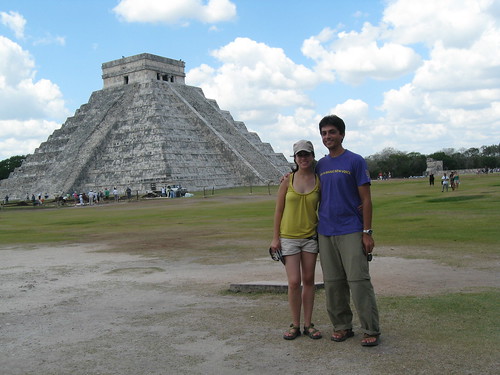
On our fourth day, we were destined for one of the new wonders of the world, Chichén Itzá. I had been with my family back in 2005, but surprisingly enough, Maru had never been there, and she needed to check it off her list. Before heading out, we knew that we would want a little more information than you can get from the seemingly random plaques placed around Mexican archaeological sites, and we don’t like to hire guides too often (you never know if you’re hiring someone who actually knows what they are talking about, and they can be restrictive), so we had purchased a little guide book with descriptions of all the major installments of the site.
We got there at about 9:15 in the morning, well before the crowds showed up, and we began our exploration. Seeing the ancient city in the light of our trip down the Puuc Route on Tuesday and with the guide book pointing out key elements of the different structures really helped us to appreciate what it is that makes this site so special. I understand that for some people out there, archaeological sites aren’t anything to write home about, but we both love visiting and learning the little that is known. There is always something to discover, even in a site previously visited. After all, these sites are all, quite literally, entire cities, and we like to dig into the nooks and crannies. Of course, we also appreciate the grandeur of famous buildings like the Castillo de Kukulcán (the really famous flagship image of the site), but where you garner an appreciation for the sheer workmanship is in the details, and oh, does Chichén have details.
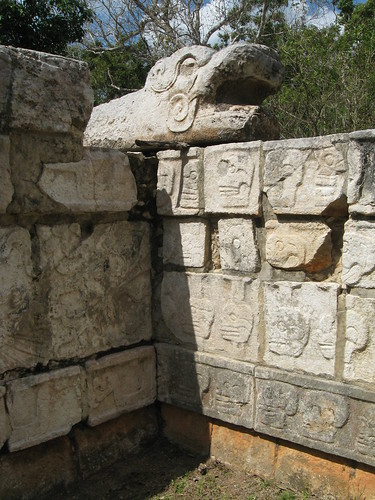
Everywhere you look, there are bas-relief carvings depicting everything from the ball game to creation to other legends and totems. And in a couple of places, the paint is still intact, and you can get an idea of what the murals originally looked like. We are total nerds and really get into speculating about what certain spots might have looked like or how they might have been used. Both Maru and I went through a want-to-be-an-archaeologist phase as kids. It is simply fascinating to contemplate cultures that are long gone but left such a lasting mark. While Mayan people still live and thrive along with their language and even some aspects of their cuisine, the specific culture that built these cities is really known to no one. In addition to the genocide of the conquistadors, there was a lot of fluctuation among the ancient civilizations themselves through trade, war, and even spiritual conversion. Later, in the anthropology museum, we learned that there is clear evidence that the Mayans ended up with products that had come from the southwestern US! That’s transregional trade on a level comparable to the Mediterranean, Indian Ocean, and the China Sea at the time.
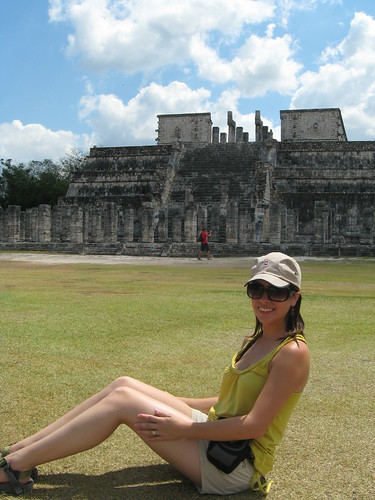
Maru posing like Chaac.
In total, we spent about 3 hours in the ruins of Chichén. Hunger and heat drove us out of the site. By the time we left, even more crowds had gathered. The place looked almost like Disney World with lines of international tourists. If you ever go, get there early.
Our next stop on the itinerary was the town of Izamal, but it was about an hour drive and we had some priorities. Being hot and hungry we wanted two things: a swim in a cenote and a snack! Priority one was the snack, and on our way through a little town called Libre Unión we saw a nice looking fruit stand. We ended up both eating a heaping plate of fruit that was prepared for us by a very nice woman while her equally nice husband offered us his chair in the shade and chatted with us about lots of different topics. He asked questions about our trip, we asked him questions about the area, he asked questions about Puebla and the US, we asked questions about his family, and he even tried to teach us how to count in Maya, but I think we were too sun-dazed to be very good students. When we asked him about a nearby cenote, he pointed us in the right direction, we paid for our fruit, exchanged well-wishes, and headed out.
While our snack necessities had been met with a pleasant and refreshing experience well beyond expectations, things then fell short due to a somewhat disappointing cenote encounter. It was just outside of town, down a dirt road, and the rock formations around it were beautiful, and the thing was abuzz (literally) with life, but there was a little too much pond scum and algae for either of us to take a dip. And, from the hollow on the other side came a buzzing echo of a hive of bees or hornets that sounded like something out of a horror movie about killer bees. Once we decided that the buzzing was getting louder, we decided to get back in our car and throw in the towel on our swim. We just cranked the AC to lower our core temps a bit.
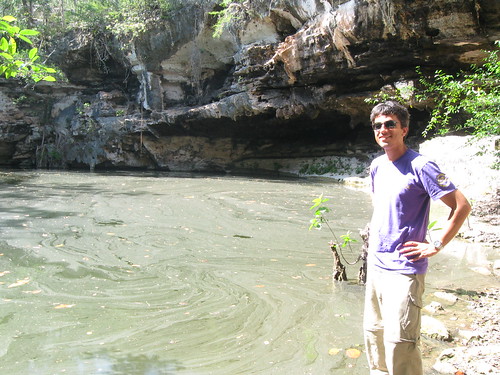
Yeah, that didn't look very refreshing.
Then we arrived in Izamal, an official Pueblo Mágico, and it lived up to its title. As soon as we pulled up to park along the square, an elderly local official waved us into a spot and then greeted us with one of the most cordial welcomes I have ever gotten from a stranger. He pointed out the major destinations, which are principally four pyramids and an enormous Franciscan monastery. For some reason, which we didn’t investigate, the entire town is painted in sunshine yellow. I know, it sounds nauseating, but it actually works. The place looks great, and they have obviously invested quite a bit in public works to fix facades and beautify the public spaces. But before indulging fully in Izamal’s beauty, we had to eat for real. The fruit was wearing off and we needed a meal.
I had read about a restaurant called Kinich (and Rick Bayless had tweeted from there), but I wasn’t sure if it was going to just be touristy and expensive or actually good. Thankfully, it was the latter, in spades. I can safely say it was hands down the best dining experience of our trip; pleasant atmosphere, great service (a serious rarity in Mexico), totally reasonable prices, and of course, the food. Wow. I got a Chaya water to drink and Maru got herself a well-deserved Coke, then our waitress brought us sikil pak and tortilla chips while we perused the enticing menu items. Sikil pak is a dip made from pumpkin seeds and seasonings, like the texture of guacamole. We started with a sopa de lima (even better than the one from the previous day) and rice with fried plantains, then we finally tried papadzules. They are tortillas filled with chopped hard-boiled egg on a bed of a sauce made from pumpkin seeds and epazote. Traditionally, they are topped with more egg and a tomato sauce, but the ones we ordered came topped with longaniza de Valladolid, a chorizo from another major town in Yucatán. One of the best things we ate on the entire trip. I about licked the plate clean. Then came our tzik, which is slow-roasted venison shredded and mixed with onion, radish, and cilantro. They gave us handmade tortillas to eat it on, and it was gone in a flash. For dessert, we shared a very nice little flan. Ahh, Kinich. We wanted to go back like three more times.
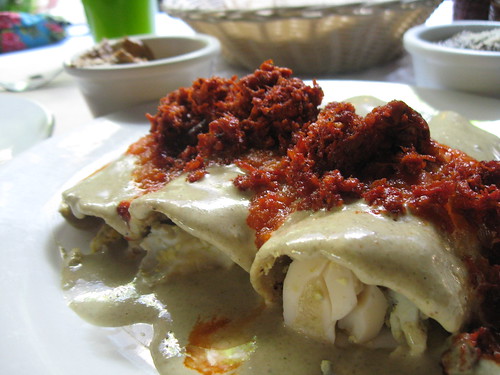
Papadzules. Be jealous.
Fully satisfied, we began our exploration of Izamal, which was kicked off by, you guessed it, scaling another pyramid. The thing must have been huge originally, but like the pyramid in Cholula, it is mostly overgrown, so you have to imagine its scale. Once we were on top, you could see for miles in every direction, with a superb view of the town below. After climbing down, we walked to the monastery, which is purported to have the biggest church courtyard outside of the Vatican. It’s big.
Speaking of the Vatican, good old John Paul II gave mass at this monastery in 1993. Apparently, it was a big deal. There’s a statue and a portion of the museum dedicated to his visit during which he gave their statue of the Virgin Mary a crown and pearl necklace.
Pope John Paul II was and is adored in Mexico as he visited the country numerous times. We were just upset because when we read the speech that he had given during the mass, he pretty much declared the landing of Christopher Columbus as a holy event ("when the cross crossed the ocean," or something to that effect) and blathered on about the church always supporting the indigenous communities through hard times. Um, are you referring to the hard times directly sanctioned and instigated by the institution you were basically the CEO of? I felt my tzik coming back up after reading that. Yes, John Paul, the cross came across the ocean, along with disease, inquisition, oppression, enslavement, and the overall systematic eradication of hundreds of indigenous cultures, i.e. genocide. I definitely recognize that the pyramids and archaeological sites we admire were also built on the backs of slaves, but I think that people forget too quickly that every colonial church in the Americas is a veritable monument to the genocidal founding of our nations. The sick irony of it is that Latin America is 70-80% Catholic. Conquest: win. Remembering of history: fail. Anyway, here we all are.
We stepped out of the church museum and enjoyed a beautiful sunset over the main square while a military band practiced on their bugles. I am pretty sure that the definition of quaint was being clearly illustrated for us. On our way back to Mérida, we were content, thoughtful, and tired.
Here is the link to all of our pics.
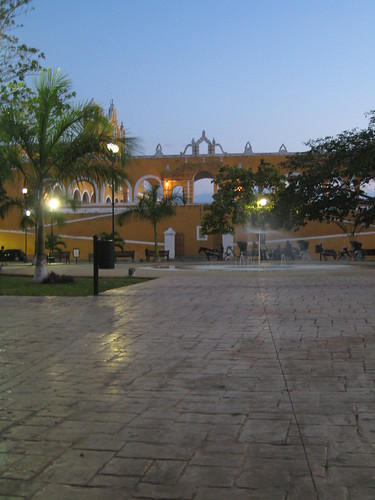

It was a fantastic day babe! I love the detailed description of it :)
ReplyDeleteYou only forgot to say that we actually looked into going to a different cenote. The thing with it was that a) it was private (?) and b) it was really expensive. B was the reason why we didn't swim in it but the guy said that the cenote was about 100 meters in diameter. Probably the biggest we would have ever seen. Oh well. Izamal took my mind off of cenotes :)